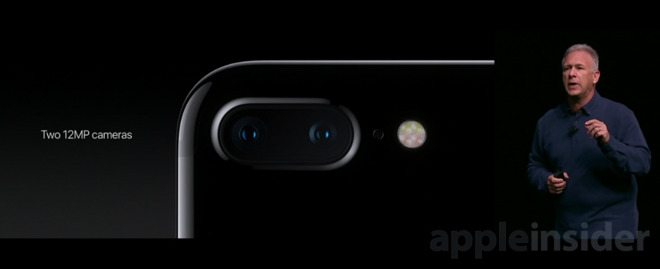This year's iPhone 7 series features a number of upgrades throughout, including a new jet black glossy finish option, a click-free pressure sensitive home button, and the best mobile cameras Apple has ever offered. Storage has been doubled, and preorders begin this Friday ahead of a Sept. 16 launch.

iPhone 7: External changes
Apple put a particular emphasis on a new glossy "jet black" finish, with antennas that are subtly integrate into the color scheme. Color and finish options for the family are aluminum with a black logo, gold, silver, and rose gold.
The home button is also getting a makeover with this year's iPhone, making it completely reengineered with a force sensitive design and new generation "Taptic Engine."
A10 Fusion processor 120x faster than original iPhone, storage up to 256 GB, brighter screen, stereo speakers, vastly improved camera assemblies with optical zoom on iPhone 7 Plus
it also features quick actions like moving widgets, messages, notifications, and ringtones. It can also be programmed by third-party applications with a new Taptic Engine API.
It's also water resistant, keeping out liquid and dust that can cause damage.
As expected, the iPhone 7 will ditch the headphone jack, shipping with Lightning-connected EarPods in the box, as well as a Lightning to headphone adapter.
Apple will also sell separate AirPods Bluetooth headphones, with the new W1 wireless chip, alongside the iPhone 7.
Camera shakeup
The iPhone 7 family features optical image stabilization across-the-board in all models with a larger f/1.8 aperture lens that lets in 50 percent more light. A new six-element lens has been adapted, coupled with a high-speed 12-megapixel sensor that's 60 percent faster and 30 percent more energy efficient.
The True Tone flash features four LEDs that put out 50 percent more light. Also implemented is a "flicker sensor" to detect the cycling of artificial lighting, automatically compensating for it in photos and videos.
The camera is powered by an Apple-designed image signal processor that detects faces and bodies, sets exposure, sets white balance, captures wide color, reduces noise, and much more.
The forward facing FaceTime HD camera has been upgraded to 7 megapixels, up from 5 megapixels. It also includes new pixel technology like deep trench isolation, and can capture wide color images and auto image stabilization.
The 5.5-inch iPhone 7 Plus ups the ante with two 12-megapixel cameras --Â one with a wide-angle lens, while the other is telephoto. This allows users to change the focal length of the lens, bringing optical zoom to the iPhone for the first time.
Combined with software zoom, images can be magnified up to 10x, doubling that of the previous iPhone's capabilities. Optical zoom maxes out at 2x.
The dual-camera system is also capable of simulating shallow depth of field, or "Bokeh." It uses machine learning to recognize people and faces, then creates a depth map to keep people in focus while the background is blurry.
"This is a huge breakthrough in what can be done with a smartphone and photography," Apple marketing chief Phil Schiller said on Wednesday.
Depth of field capabilities were only previewed at Wednesday's event --Â they'll arrive for iPhone 7 Plus in a software update later this year.
Display, speakers
The display on the iPhone 7 series is 25 percent brighter, and features a wide color display with the cinema P3 standard as found on the 9.7-inch iPad Pro. Like the iPhone 6s, it also includes 3D Touch input.
Apple has also introduced stereo sound on the iPhone 7 for the first time, utilizing one speaker on the bottom of the case, and the phone's earpiece. The speakers are said to be up to 50 percent louder than any previous iPhone installation.
A10 Fusion processor
Inside, the iPhone 7 features a four-core 64-bit processor dubbed the A10 Fusion. Apple claims the new processor delivers speeds of up to 120 times faster than the original iPhone.
Two of the cores are high-performance cores running at 40 percent faster than the A9 chip, while the other two are high-efficiency, running at one-fifth the power of the high-power ones. A new Apple-designed performance controller directs traffic to the processors, and optimizes for either performance or battery life.
Apple noted tasks such as e-mail receipt able to be performed on the high-efficiency processors, lowering battery demand for those tasks.
As a result of the quad-core design, and the custom-designed performance controller, the iPhone 7 and iPhone 7 Plus have the "longest battery life ever in an iPhone" according to Schiller.
The new integral GPU is said to be 50 percent faster than the A9 and three times faster than the A8. It consumes just two-thirds of the power under full load of the A9 and half the power of the A8.
Graphics performance on the iPhone 7 is claimed to be up to 240 times faster than the first-generation iPhone, and 50 percent faster than A9-equipped iPhones.
Pricing and availability
The 5.5-inch iPhone 7 Plus starts at $769 for 32 gigabytes of storage. Apple will charge $869 for 128 gigabytes, and $969 for 256 gigabytes.
The 4.7-inch iPhone 7 starts at $649 for 32 gigabytes, up to $849 for 256 gigabytes. Preorders will begin this Friday, Sept. 9, and the product begins shipping a week later on Sept. 16.
The jet black finish for both the 4.7-inch iPhone 7 and 5.5-inch iPhone 7 Plus come in only 128 GB and 256 GB capacities.
The previous-generation iPhone 6s and 6s Plus will be retained in the lineup, with storage has also been upgraded to 32GB and 128GB. The iPhone SE will also still be available, and remains unchanged.
In parallel with the iPhone 7 availability, iOS 10 will arrive as a free update on on Sept. 13 for all compatible devices.


